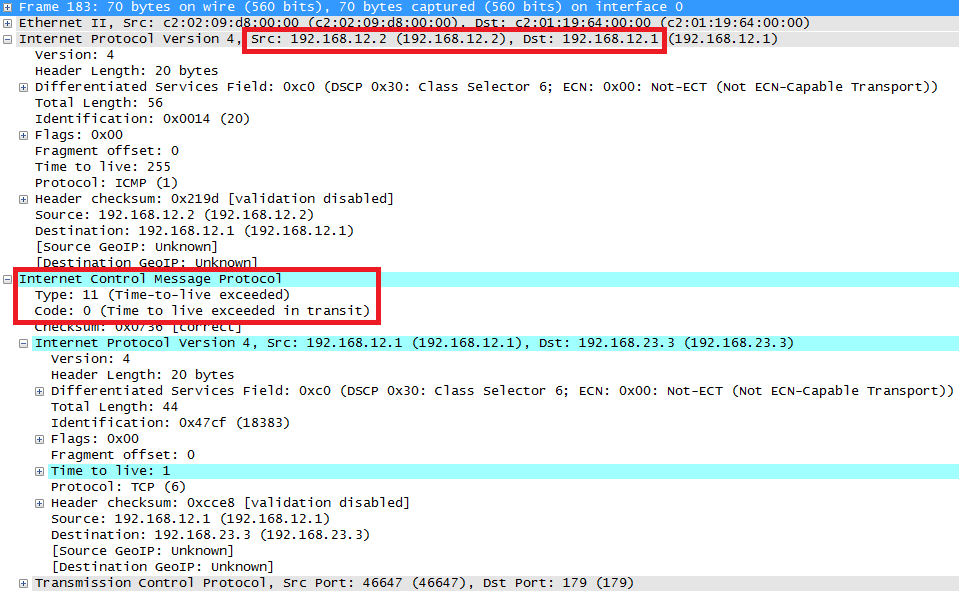eBGP (external BGP) by default requires two Cisco IOS routers to be directly connected to each other in order to establish a neighbor adjacency. This is because eBGP routers use a TTL of one for their BGP packets. When the BGP neighbor is more than one hop away, the TTL will decrement to 0 and it will be discarded.
When these two routers are not directly connected then we can still make it work but we’ll have to use multihop. This requirement does not apply to internal BGP.
Here’s an example:

Above we will try to configure eBGP between R1 and R3. Since R2 is in the middle, these routers are more than one hop away from each other. Let’s take a look at the configuration:
R1(config)#ip route 192.168.23.3 255.255.255.255 192.168.12.2R3(config)#ip route 192.168.12.1 255.255.255.255 192.168.23.2First I will create some static routes so that R1 and R3 are able to reach each other. Now we can configure eBGP:
R1(config)#router bgp 1
R1(config-router)#neighbor 192.168.23.3 remote-as 3R3(config)#router bgp 3
R3(config-router)#neighbor 192.168.12.1 remote-as 1Even though this configuration is correct, BGP will not even try to establish a eBGP neighbor adjacency. BGP knows that since these routers are on different subnets, they are not directly connected. We can verify this with the following command:
R1#show ip bgp neighbors | include External
External BGP neighbor not directly connected.R3#show ip bgp neighbors | include External
External BGP neighbor not directly connected.Just for fun, let’s disable this check so that R1 and R3 try to become eBGP neighbors. We can do that like this:
R1(config-router)#neighbor 192.168.23.3 disable-connected-checkR3(config-router)#neighbor 192.168.12.1 disable-connected-checkOur routers will now try to become eBGP neighbors even though they are not directly connected. Here’s what happens now:

The wireshark capture above shows us that R1 is trying to connect to R3. As you can see the TTL is 1. Once R2 receives this packet it will decrement the TTL by 1 and drop it:

Above you can see that R2 is dropping this packet since the TTL is exceeded. It will send an ICMP time-to-live exceeded message to R1. Our BGP routers will show a message like this:
R1#
BGP: 192.168.23.3 open failed: Connection timed out; remote host not responding, open active delayed 27593ms (35000ms max, 28% jitter)This is R1 telling us that it couldn’t connect to R3. To fix this issue, we’ll tell eBGP to increase the TTL. First let’s enable the directly connected check again:
R1(config-router)#no neighbor 192.168.23.3 disable-connected-checkR3(config-router)#no neighbor 192.168.12.1 disable-connected-checkAnd now we will increase the TTL:
R1(config-router)#neighbor 192.168.23.3 ebgp-multihop 2R3(config-router)#neighbor 192.168.12.1 ebgp-multihop 2Use the ebgp-multihop command to increase the TTL. Using a value of 2 is enough in our example. R2 will receive a packet with a TTL of 2, decrements it by 1 and forwards it to R3. We can verify this change by looking at the show ip bgp neighbors command:
R1 & R3
#show ip bgp neighbors | include External
External BGP neighbor may be up to 2 hops away.R1 and R3 both agree that the BGP neighbor could be 2 hops away. Here’s what the BGP packet looks like in wireshark:

This capture shows us the TTL of 2. After a few seconds, our routers will become eBGP neighbors:
R1#
%BGP-5-ADJCHANGE: neighbor 192.168.23.3 UpR3#
%BGP-5-ADJCHANGE: neighbor 192.168.12.1 UpThat’s it, problem solved!
Configurations
Want to take a look for yourself? Here you will find the final configuration of each device.
R1
hostname R1
!
interface fastEthernet0/0
ip address 192.168.12.1 255.255.255.0
!
ip route 192.168.23.3 255.255.255.255 192.168.12.2
!
router bgp 1
neighbor 192.168.23.3 remote-as 3
neighbor 192.168.23.3 ebgp-multihop 2
!
endR2
hostname R2
!
interface fastEthernet0/0
ip address 192.168.12.2 255.255.255.0
!
interface fastEthernet1/0
ip address 192.168.23.2 255.255.255.0
!
endR3
hostname R3
!
interface fastEthernet0/0
ip address 192.168.23.3 255.255.255.0
!
ip route 192.168.12.1 255.255.255.255 192.168.23.2
!
router bgp 3
neighbor 192.168.12.1 remote-as 1
neighbor 192.168.12.1 ebgp-multihop 2
!
endNow you understand how eBGP multihop works, let’s take a look at a more useful scenario:

Above we have two routers…R1 and R2. They are directly connected but we have two links in between them and we would like to use these for load balancing. Instead of using the IP addresses on these FastEthernet interfaces for the eBGP neighbor adjacency we will use the IP addresses on the loopback interfaces for this. Let’s take a look at the configuration:



Rene,
I thought multi-hop is only when we have two BGP neighbors are not directly connected. I can see in the example when loopback addresses are used to configure BGP neighbors you are using multi-hop command even thoug the routers are directly connected.
In the first example and your note says having non BGP router between two BGP routers is not a good idea. For instance if we have no choice then how can we make sure R1 and R3 networks are reachable?
Please clarify.
Thanks
Hamood
Hi Hamood,
That’s right, if you source eBGP from the loopback interfaces then you’ll need multihop.
The problem with the R1-R2-R3 scenario is that R2 will never learn about any prefixes, when R1 tries to reach a network behind R3 (or R3 wants to reach something behind R1) then R2 will receive an IP packet with a destination it doesn’t know about.
If you really had to use eBGP between R1 and R3 then a GRE tunnel might be a solution…
Rene
Hello Rene,
If we use static routes then why we use BGP? couldn’t we advertise the subnets with network command in BGP?
Thanks,
-Rouzbeh
Hi Rouzbeh,
In the example with the two interfaces, we use static routes only for the neighbor adjacency. Once BGP is up and running, we’ll use it to advertise networks. With only two routers there’s no need to run BGP, just imagine that R1 and R2 are part of a much larger network with multiple ASes, routers, etc.
Rene
Is BGP neighbor command not enough to build the adjacency? I mean with 2 routers static route is mandatory?
Thanks,
-Rouzbeh